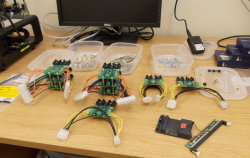Towards more efficient HPC and embedded systems
High-Performance Computing (HPC) requires enormous amounts of power. A single HPC system for example will have hundreds of thousands of parallel components that require significant energy to run and cool. This has an impact on both cost and the environment. The EU-funded ADEPT project has sought to address this challenge by developing tools capable of predicting and modelling performance and power usage. This will enable developers to make more informed decisions about which hardware and software they choose to implement. ‘A key success of this project has been integrating performance and energy consumption modelling for HPC and embedded systems,’ explains project coordinator Dr Michele Weiland from the Edinburgh Parallel Computing Centre (EPCC) at the University of Edinburgh, UK. ‘Specialised benchmarks have been developed to provide detailed insights into how systems utilise energy and power.’ By using metrics that measure ‘work done per unit energy’, the tools are able to compare the efficiency of different systems. In doing so, the project aims to deliver increased performance in both HPC and embedded systems at lower energy costs. Unlike HPC, embedded systems are computer systems with specific functions. They control many everyday devices ranging from portable electronics such as digital watches and MP3 players to large stationary installations like traffic lights and hybrid vehicles. Some 98 % of all microprocessors are manufactured as components of embedded systems. ‘A key reason for the success of the project has been the effective crossover between HPC and embedded computing,’ says Weiland. ‘Energy-efficient technologies in the embedded sector are common. At the same time, embedded systems engineers are increasingly interested in using technologies to achieve higher performance. We’ve tried to find synergies between both disciplines, where both can learn from each other.’ For example, a major trend within embedded systems has been towards ever lower power consumption, smaller size and lower per-unit cost. With fifth generation (5G) mobile networks on the way, embedded systems developers are increasingly prioritising higher performance. It therefore made perfect sense to the project team to encourage the embedded and HPC sectors to work together, in order to achieve the right balance between power use and performance. ‘The strengths of one sector are the weaknesses of the other,’ explains Weiland. ‘Embedded systems are not that strong at using high performance technologies at present, while supercomputing has an issue with efficiency. So by working together, we have been able to address challenges faced by both sectors. This will have a knock-on effect on consumer technologies as progress intensifies.’ Bringing together experts from both fields, the ADEPT project began by investigating the implications of hardware and software choices on power consumption. From this, the project’s tools were successfully developed. ADEPT is scheduled for completion in August 2016, and it is consolidating exploitation plans regarding the key project outputs: a power measurement system, the benchmarks (released as open source and are available to download from the project’s website), and a performance and power prediction tool. Together with the benchmarks, the power measurement system has already been used by research projects and commercial hardware developers outside of ADEPT. Efforts are currently underway to assess how the measurement system can be made portable and easier to use for non-experts, and whether there is a demand for power measurement “as a service”. In addition, the power and performance prediction tool is under active evaluation by Ericsson in a production environment (one of ADEPT partners), and the feedback will be also useful for increasing the maturity and stability of the tool. For further information please visit the ADEPT project website.
Keywords
ADEPT, HPC, high performance computing, energy, embedded systems, power



